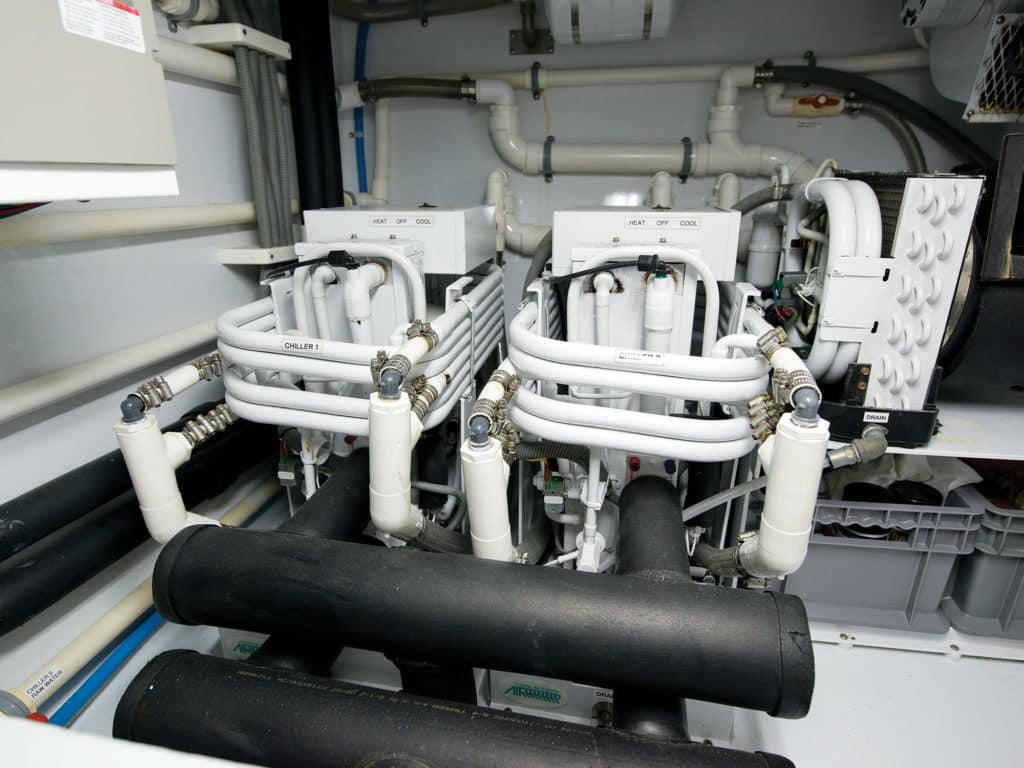
Given the size of today’s sport-fishing boats, the large majority of builders use chilled-air systems to cool their boats. This type of system works by circulating cooled fresh water through a closed loop connected to several air handlers throughout the boat. The other style of air-conditioning system used in boats — especially smaller ones — is a direct-expansion system, which operates by pumping the refrigerant directly to the boat’s individual air handlers. Most air-conditioning systems have three main components: the evaporator, compressor and condenser. All three serve an important function in the cooling system and require specific attention to details to maintain efficient function.
The Importance of Accessibility
Keeping a chilled-air system working as efficiently as possible is not overly technical, nor it is labor-intensive or difficult as long as your builder has provided access to the components. Being able to reach the pumps and filters on the air handlers, and the ability to reach the condensate trays under the chillers and handlers will make your maintenance job much easier.
When building a boat, make sure to review the placement and accessibility of these items prior to installation. Burying air handlers behind closet walls, under settees or behind cabinets is all well and good as long as there is ample access to work on the units and clean them regularly. Placing pumps in a pump room or engine room without good access to change impellers or pump motors is the curse of every captain or engineer. Not being able to quickly service these items can cause a boat to get hot in a hurry, which is an unacceptable predicament when guests are on board.

It All Begins With the Pumps
Every chilled-air system has a minimum of two pumps: one for circulating the fresh water through the boat to chill the air handlers and another for the raw water to chill the condenser. It is wise to plumb another raw-water pump in-line so that if you have a pump failure, it’s as simple as flipping a switch and turning a valve to get the backup pump running while repairs are made to the primary pump.
Because the raw-water pump pushes so much water through it at a high rpm, the bronze impellers and the housing walls are known to deteriorate over time, reducing efficiency and even wearing to the point of complete failure.
To remedy this, we disassemble the pump heads prior to installation and coat the insides and the impeller with a product similar to a ceramic coating, called Belzona 1341 Supermetalglide (belzona.com). This product is not only proven to increase efficiency by reducing friction in pumps but inside valves and through-hull fittings as well. It also helps reduce the breakdown of metal surfaces, and it inhibits unwanted growth.
The product should not be applied too thickly because it will affect the tolerances of the impeller to the housing walls. I use an acid brush to carefully paint the coating on, being sure to completely cover all surfaces without letting the product build up or puddle. A good, evenly applied coating has increased our pump-head life from a year to over three years.
Flush It With Fresh Water
The other thing we do is to put an in‑line hose connection after the raw-water through-hull but before the pump. Using a standard ⅝-inch garden-hose connection, I can close the through-hull and hook up dockside water to run fresh water through my entire raw-water system. Once I have water coming out of the drain pipes, I let it run for about 15 minutes so that I have pushed most of the salt water through the pump, the condensers and the rest of the plumbing.
We turn off the freshwater flow and leave the system off for a day or two, then fire the pumps back up and watch all kinds of silt, detached growth and scale come out the pipes. This is much like flushing an outboard engine, and it pays huge dividends over time. If you do it frequently enough to keep things from growing and attaching to the inside walls of the hose and pipes, you will have a healthy and efficient system for a long time.
Don’t Forget the Air Handlers
The air handlers must also be routinely maintained. Cleaning the air filters on the return side of the system is critical, not only for having a good smelling and clean boat, but to give them a longer life. When filters are dirty and clogged, they are inefficient. Dirty filters are also unable to remove humidity from the air, which is a major component of their healthy function.
If the grill and coils on the air handler itself gets loaded with dust and dirt, the unit will continue to degrade and its efficiency will plummet. We routinely clean the filters as often as every week to keep them clean and working properly. Keeping the boat clean is another key factor in making sure the air handlers and filters are clean. Routinely wiping down all the woodwork, vacuuming the carpet and cleaning the runners helps reduce dust and dirt that could get pulled into the return air and start clogging the entire air-conditioning system.
With just a bit of effort, you can reduce the need for expensive repairs and frequent visits from your air-conditioner guys. Prolonging the life of your units and keeping their efficiencies as high as possible makes for trouble-free trips and cool times aboard. As always, preventive maintenance is the best antidote to costly repairs.







